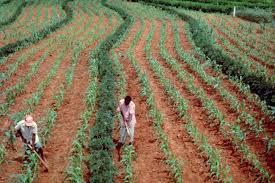Evaluation of cabbage intercropped with seed spices on black clay soil
Keywords:
Cabbage, intercropping, sub-humid tropics climate, Typic HaplustertAbstract
Due to depleting percapita land consistent stress on improving factor productivity has warrantedmany alternative cropping strategies. The effect of intercropping beetroot(Beta vulgaris, Cv. Datroit Dark Red), radish (Raphanus sativum, Cv. JapaneseWhite), fenugreek (Trigonella foenumgraecum, Cv. Pusa Early Bunching),coriander (Coriandrum sativum, Cv. Local), Spinach (Spinacia oleracea, Cv. PusaJyoti) and sorrel (Rumex acetosa, Cv. Local) on the growth, yield and qualityof cabbage as main winter crop was tested in a black clay soil (TypicHaplustert), low in available nitrogen and optimum in available P and K underhot sub-humid tropical climate of Central India. Higher values for all thegrowth parameters of cabbage were recorded as a sole crop. Nevertheless,cabbage plus radish produced maximum net yield followed by cabbage plus spinachand cabbage plus coriander. No difference in total soluble solids was observedeither when cabbage was taken alone (10.1° brix) or in combination withintercrops (9.0-10.0° brix). The study hence suggested the superiority ofintercropped cabbage over sole crop.References
Coolman, R.M., Hoyt, G.D., 1993. Increasing sustainability by intercropping. Hort. Tech., 3(3), 309-12.
Jackson, M.L., 1973. Soil Chemical Analysis. Prentice Hall of India Pvt. Ltd. New Delhi. India., pp. 111-183.
Mehrotra, O.N., Ali, A.A., 1970. A scientific analysis of mixed cropping. Sci. Culture., 36(4), 196.
Omar, N.M., Gomaa, H.M., Bhairy, A.G., Ali, A.H., 1989. Seed germination and seedling growth of tomato as affected by root exudates of cabbage. cauliflower and radish. Egypt. 1. Hor., 6(2), 165-171.
Ranganna, S., 1986. Handbook of Analysis and Quality Control for Fruit and Vegetable Products. Tata Mc Graw Hill Publication Co. Ltd . New Delhi., pp 881-882.
Rahangdale, S.M., Urnale, S.B., Shriram, A.S., Mahorkar, V.K., 1995. Effect of intercrops on growth and yield of cabbage. Punjabrao Krishi Vidyapeeth Res. J., 19 (2), 196-197.
Subbiah, B.V. Asiza, L.G., 1956. A rapid method of available N estimation. Curr. Sci., 25, 159-160.
Theunissen, J., Booij, C.J.H., Scheling, G., Noorlander, J., 1992. Intercropping white cabbage with clover. Bulletin OILB/SROP., 15 (4), 104-114.
Thompson, H.C. Kelly, W.C., 1959. Vegetable Crops. Tata McGraw Hill Publishing Co. Ltd.New Delhi., pp.150-152.
Varghese, L., 1999. Sustainability of Intercropping Vegetable farming in Typic Haplustart. Int. Conf. Manag. Natural Res. for Sustainable Agricultural Production in 21st Century. New Delhi. India. February., 14-18, 2000.
Varghese, L., 1999., Evaluation of cabbage based intercropping systems in Typic Haplustart. Abstract, 4th Agricultural Science Congress, Jaipur (Rajasthan), India. February., 21-24, 1999 pg. 257.

Published
How to Cite
Issue
Section
Copyright (c) 2013 L. Varghese

This work is licensed under a Creative Commons Attribution-NonCommercial-NoDerivatives 4.0 International License.



